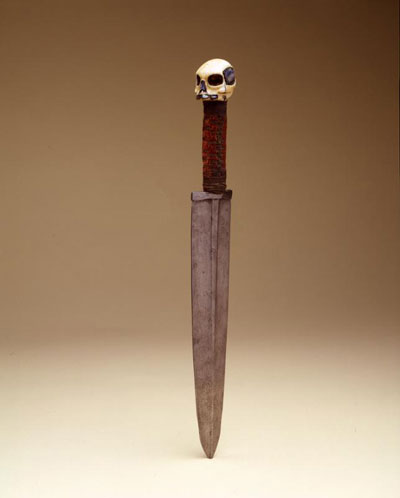
Museum Object Number: NA8488.
Tlingit art holds Tlingit histories and, as Louis Shotridge insisted, the native point of view enables us to understand its meaning. One object Shotridge collected embodies some of the indigenous knowledge recorded on the map that Kohklux and his wives drew for outsiders in 1869. “The Ghost of Courageous Adventurer” dagger is a Tlingit war knife whose story records an epic journey through the landscape just north of Klukwan. Shotridge collected the dagger from a leading t lingit elder in 1917 and published its story in the Museum Journal three years later. “ the ghost of Courageous adventurer” honors the strength and resolve of a group of 20 Tlingit men, led by as hangukeidi man named eagle head, who long ago embarked on a treacherous journey on foot from Klukwan on the Chilkat river over the rugged Saint Elias Mountain range to the Copper River, and back again, to investigate neighboring tribes. the expedition took several months and saw extraordinary hardship, starvation, and loss of life as the men crossed rivers, mountain passes, ice fields, and glacial crevices to the Pacific coast and all the way to the Copper river. Yet the excursion also had its benefits as it established new trading relationships with then unknown interior tribes and discovered new resources of iron, walrus ivory, and copper. Only a handful of men survived and returned to Klukwan to tell the story.
The dagger was made by Kaa.ushti, one of Shotridge’s own ancestors, to commemorate the journey. Kaa.ushti presented his gift to the Shangukeidi to honor and remember the strength and courage of their men. Like most Tlingit art, the dagger’s design and materials memorialize and celebrate the event itself. The blade is made of the newly discovered iron ore, and the grip is covered with woven fur of the mountain goat, also encountered on the journey. The pommel is made of walrus ivory, shaped as a human skull to represent the ancestors who made the journey, and embedded with blue iridescent abalone shell. Louis Shotridge’s efforts preserved not only the dagger itself, but the meanings behind its creation, and the ways in which its history has been passed down through generations of Tlingit clan members at Klukwan.
Lucy Fowler Williams, Ph.d
Sabloff Senior Keeper of Collections, American Section, Penn Museum
